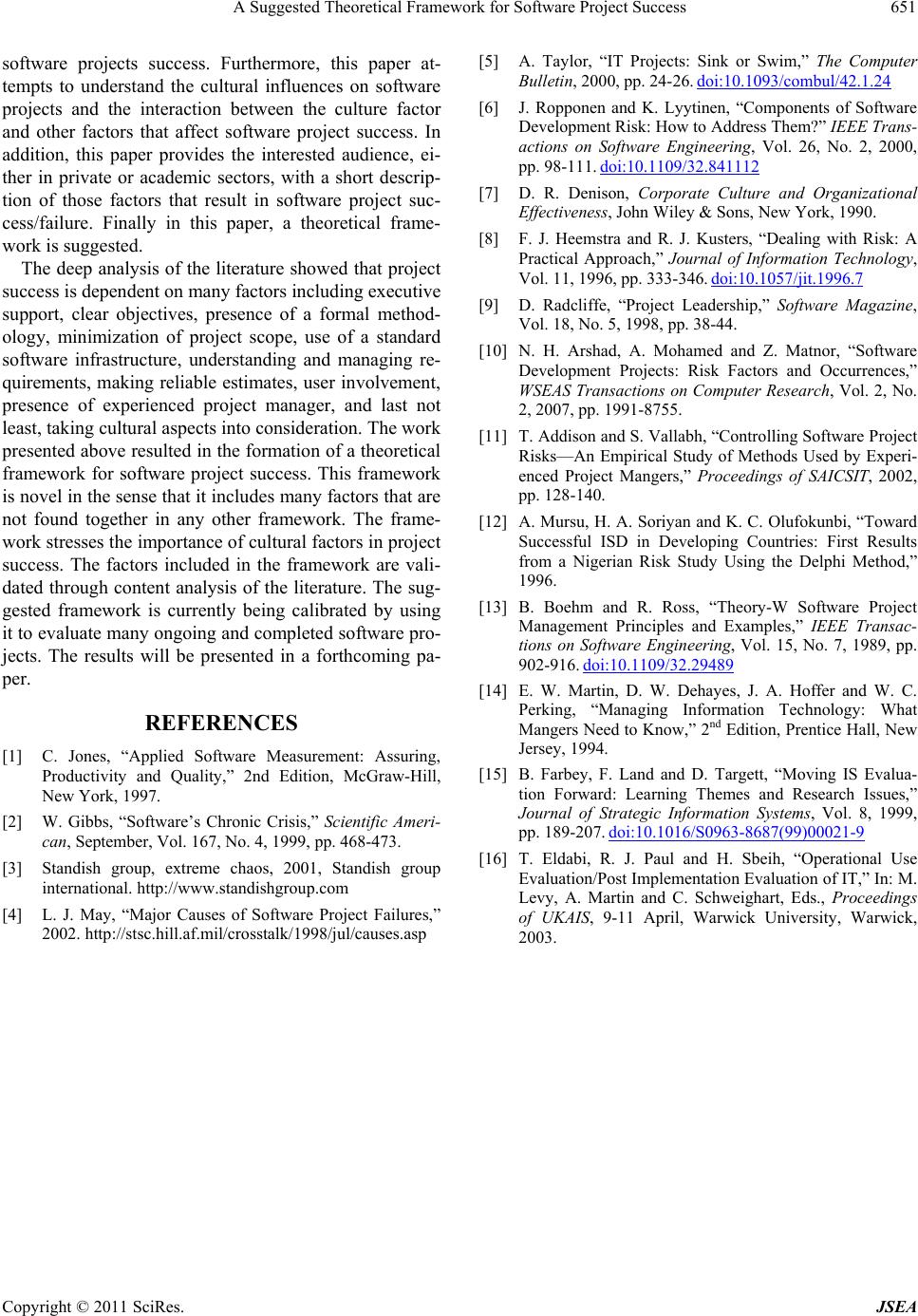
A Suggested Theoretical Framework for Software Project Success
Copyright © 2011 SciRes. JSEA
651
software projects success. Furthermore, this paper at-
tempts to understand the cultural influences on software
projects and the interaction between the culture factor
and other factors that affect software project success. In
addition, this paper provides the interested audience, ei-
ther in private or academic sectors, with a short descrip-
tion of those factors that result in software project suc-
cess/failure. Finally in this paper, a theoretical frame-
work is suggested.
The deep analysis of the literature showed that project
success is dependent on many factors including executive
support, clear objectives, presence of a formal method-
ology, minimization of project scope, use of a standard
software infrastructure, understanding and managing re-
quirements, making reliable estimates, user involvement,
presence of experienced project manager, and last not
least, taking cultural aspects into consideration. The work
presented above resu lted in the formation of a theoretical
framework for software project success. This framework
is novel in the sense that it includ es many factors that are
not found together in any other framework. The frame-
work stresses the importance of cultural factors in project
success. The factors included in the framework are vali-
dated through content analysis of the literature. The sug-
gested framework is currently being calibrated by using
it to evaluate many ongoing and completed software pro-
jects. The results will be presented in a forthcoming pa-
per.
REFERENCES
[1] C. Jones, “Applied Software Measurement: Assuring,
Productivity and Quality,” 2nd Edition, McGraw-Hill,
New York, 1997.
[2] W. Gibbs, “Software’s Chronic Crisis,” Scientific Ameri-
can, September, Vol. 167, No. 4, 1999, pp. 468-473.
[3] Standish group, extreme chaos, 2001, Standish group
international. http://www.standishgroup.com
[4] L. J. May, “Major Causes of Software Project Failures,”
2002. http://stsc.hill.af.mil/crosstalk/1998/jul/causes.asp
[5] A. Taylor, “IT Projects: Sink or Swim,” The Computer
Bulletin, 2000, pp. 24-26. doi:10.1093/combul/42.1.24
[6] J. Ropponen and K. Lyytinen, “Components of Software
Development Risk: How to Address Them?” IEEE Trans-
actions on Software Engineering, Vol. 26, No. 2, 2000,
pp. 98-111. doi:10.1109/32.841112
[7] D. R. Denison, Corporate Culture and Organizational
Effectiveness, John Wiley & Sons, New York, 1990.
[8] F. J. Heemstra and R. J. Kusters, “Dealing with Risk: A
Practical Approach,” Journal of Information Technology,
Vol. 11, 1996, pp. 333-346. doi:10.1057/jit.1996.7
[9] D. Radcliffe, “Project Leadership,” Software Magazine,
Vol. 18, No. 5, 1998, pp. 38-44.
[10] N. H. Arshad, A. Mohamed and Z. Matnor, “Software
Development Projects: Risk Factors and Occurrences,”
WSEAS Transactions on Computer Research, Vol. 2, No.
2, 2007, pp. 1991-8755.
[11] T. Addison and S. Vallabh, “Controlling Software Project
Risks—An Empirical Study of Methods Used by Experi-
enced Project Mangers,” Proceedings of SAICSIT, 2002,
pp. 128-140.
[12] A. Mursu, H. A. Soriyan and K. C. Olufokunbi, “Toward
Successful ISD in Developing Countries: First Results
from a Nigerian Risk Study Using the Delphi Method,”
1996.
[13] B. Boehm and R. Ross, “Theory-W Software Project
Management Principles and Examples,” IEEE Transac-
tions on Software Engineering, Vol. 15, No. 7, 1989, pp.
902-916. doi:10.1109/32.29489
[14] E. W. Martin, D. W. Dehayes, J. A. Hoffer and W. C.
Perking, “Managing Information Technology: What
Mangers Need to Know,” 2nd Edition, Prentice Hall, New
Jersey, 1994.
[15] B. Farbey, F. Land and D. Targett, “Moving IS Evalua-
tion Forward: Learning Themes and Research Issues,”
Journal of Strategic Information Systems, Vol. 8, 1999,
pp. 189-207. doi:10.1016/S0963-8687(99)00021-9
[16] T. Eldabi, R. J. Paul and H. Sbeih, “Operational Use
Evaluation/Post Implementation Evaluation of IT,” In: M.
Levy, A. Martin and C. Schweighart, Eds., Proceedings
of UKAIS, 9-11 April, Warwick University, Warwick,
2003.